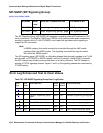
Communication Manager Maintenance-Object Repair Procedures
1972 Maintenance Procedures for Avaya Communication Manager 3.0, Media Gateways and Servers
g. Error Type 1025: the signaling group has been placed into a BYPASS condition because of
IP network congestion. The signaling group accepts incoming calls, but every outgoing call
is denied. The system routes these calls over a secondary route, if one has been
administered.
h. Error Type 1281: Implies that no medpro resources are in service to provide media
connections for the trunk members of the signaling group.
Check for errors against the MEDPRO and MEDPROPT maintenance objects. This error
causes all SIP B Channels to be in an out-of-service near-end state.
i. Error Type 1537: The far end of the signaling group is not ready to handle audio bearer. If
the other end of this signaling group is also a Communication Manager server, this error
means the server on the other end does not have MEDPRO in-service for its signaling
group.
This error places the SIP B Channels into an out-of-service far-end state.
j. Error Type 1794: The Signaling Group reported that the far end has detected excessive
packet latency or loss. This error places the SIP B channels into an out of service far-end
state.
k. Error Type 2561: This error indicates that the signaling group is registered to an LSP.
l. Error Type 3073: A TLS connection was established with the far-end but authentication
with the far-end’s TLS certificate failed. Due to this condition, the signaling group will be
placed in far-end bypass state so that no outgoing calls will be allowed, the trunks in the
group will be placed in an out of service far end state (OOSFE). Incoming calls will be
accepted, but until the far-end’s TLS certificate is remedied, these will not be successful.
Once the far-end’s certificate is remedied, an incoming call can succeed and the trunk
group will be put back in service.
m. Error Type 3329: This error indicates that the near end TLS certificate is bad. The trunks in
the group will be placed in a near end out of service state and the signaling group will be
placed in bypass. No trunk calls either incoming or outgoing will be allowed until the near
end’s certificate is corrected, the system is warm started (reset system 1), and the signaling
groups go through a busy/release action. If the near end certificate is bad, listen sockets fro
the signaling group will not be created, so this alarm is raised at the creation of the listen
socket stage (i.e., when initially bringing the signaling group into service).
Note:
Note: Near end certificate authentication is the process of validating that the server
certificate is OK, i.e., we have the private key and the certificate is trusted. This
will only break if a user with root access has changed the certificate private key
file.


















